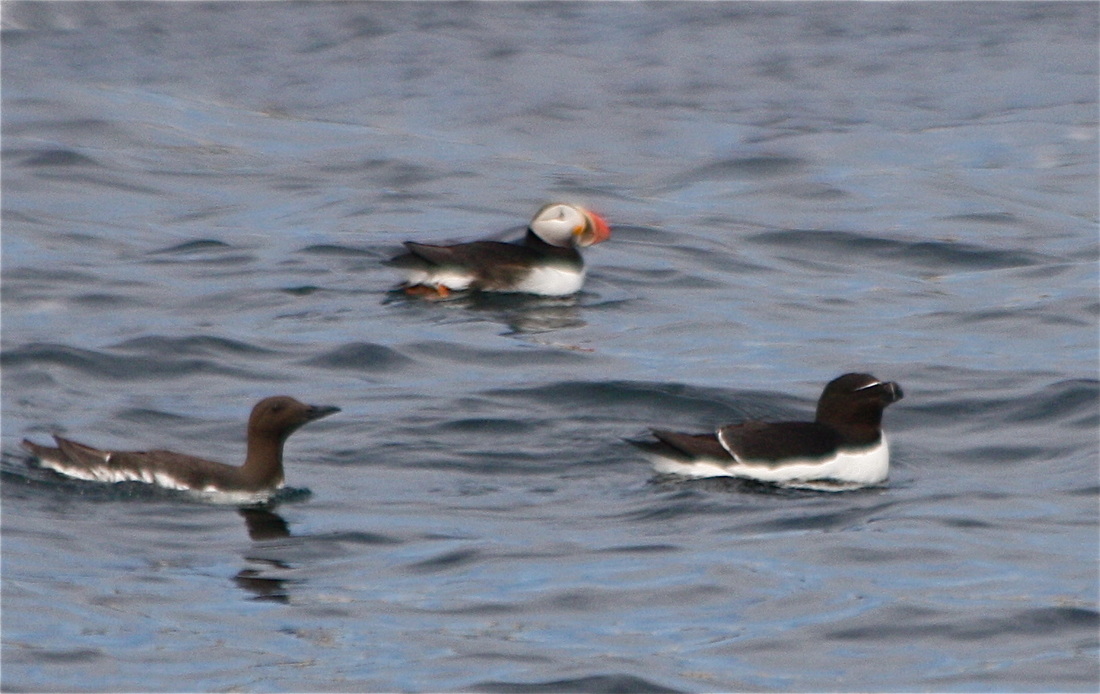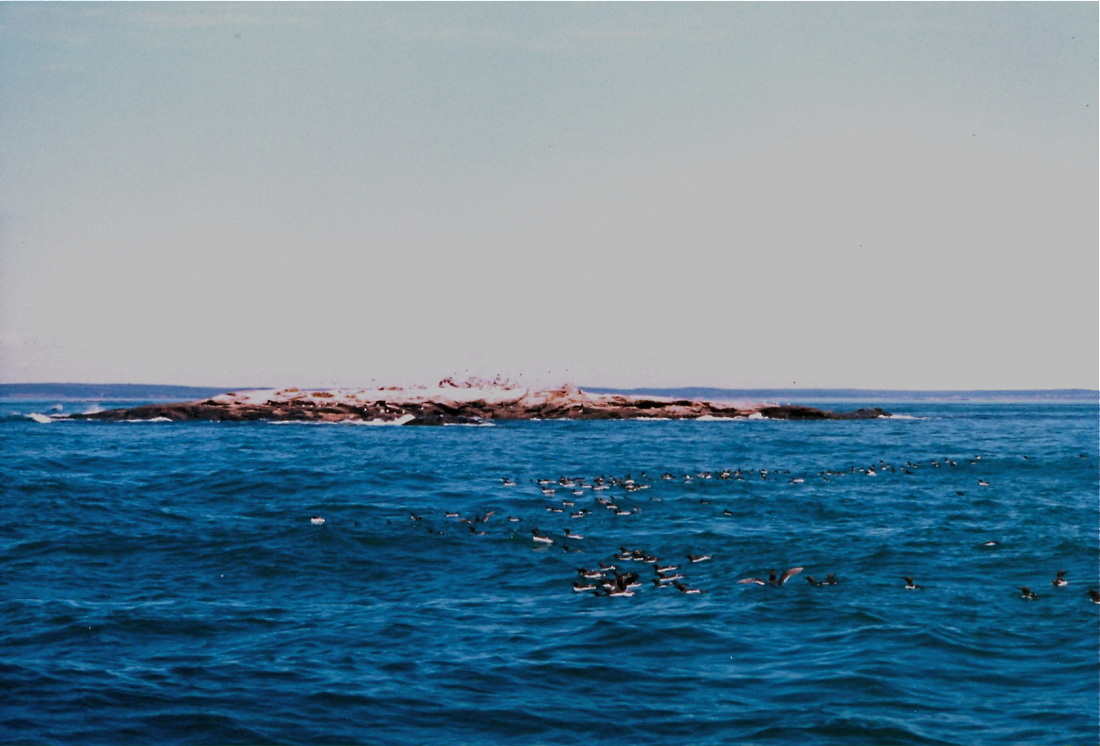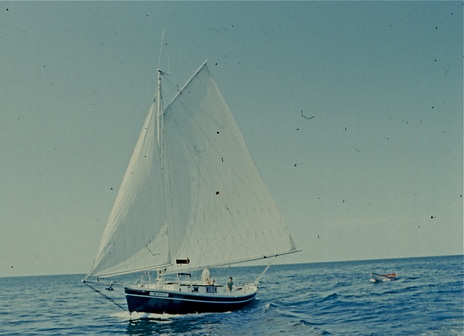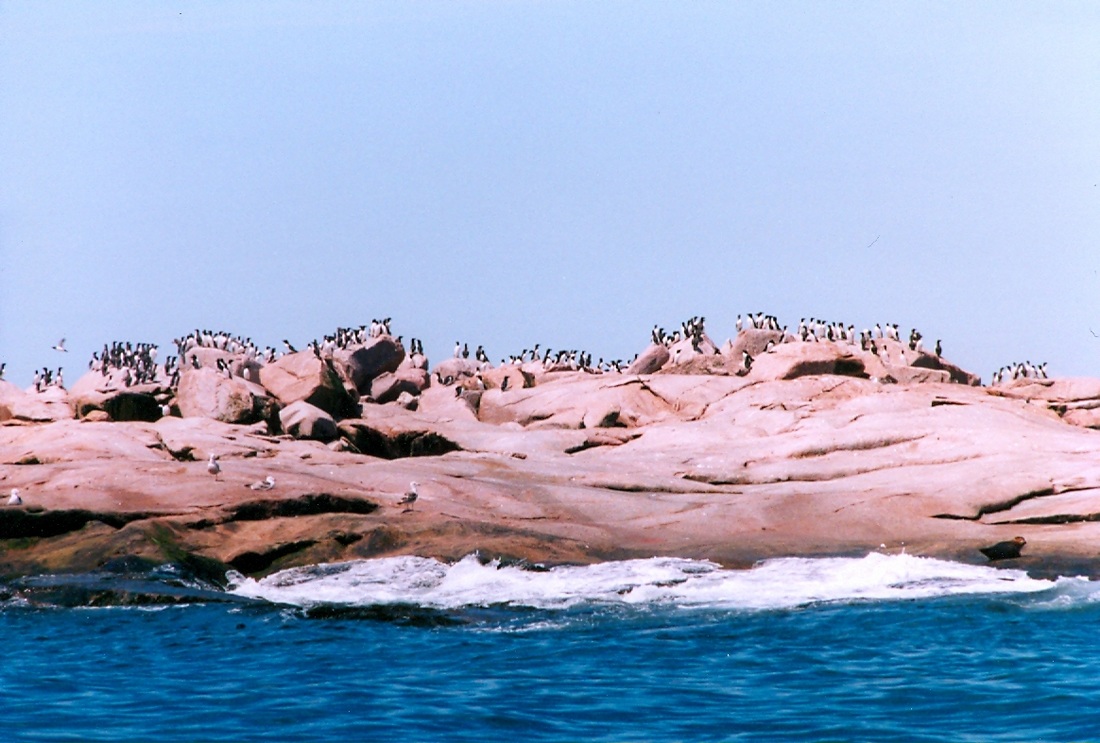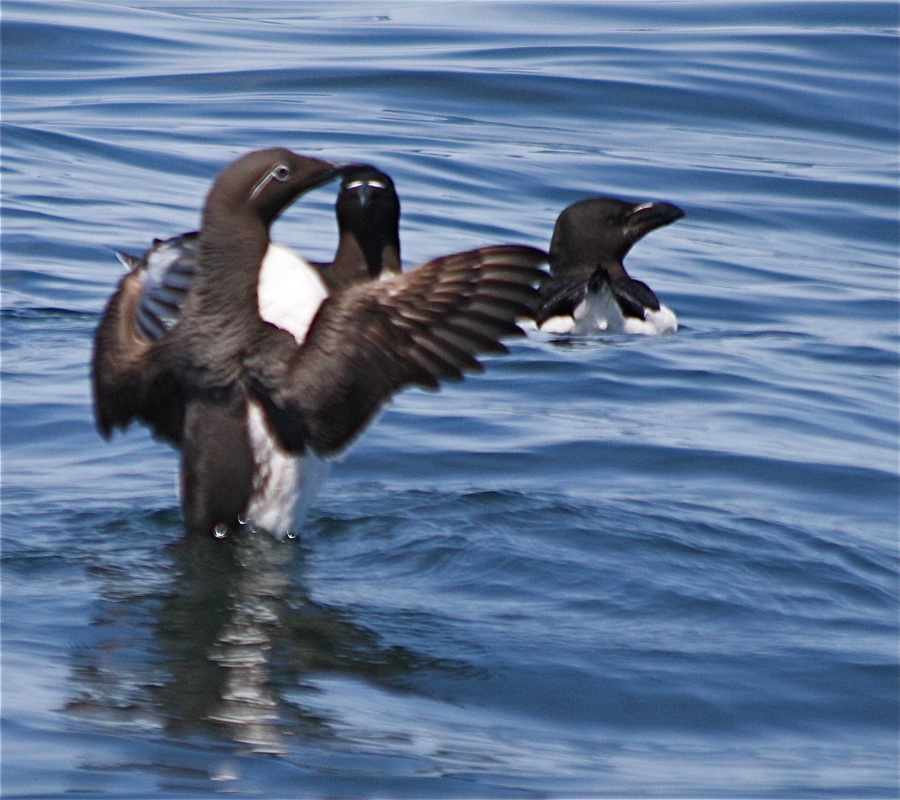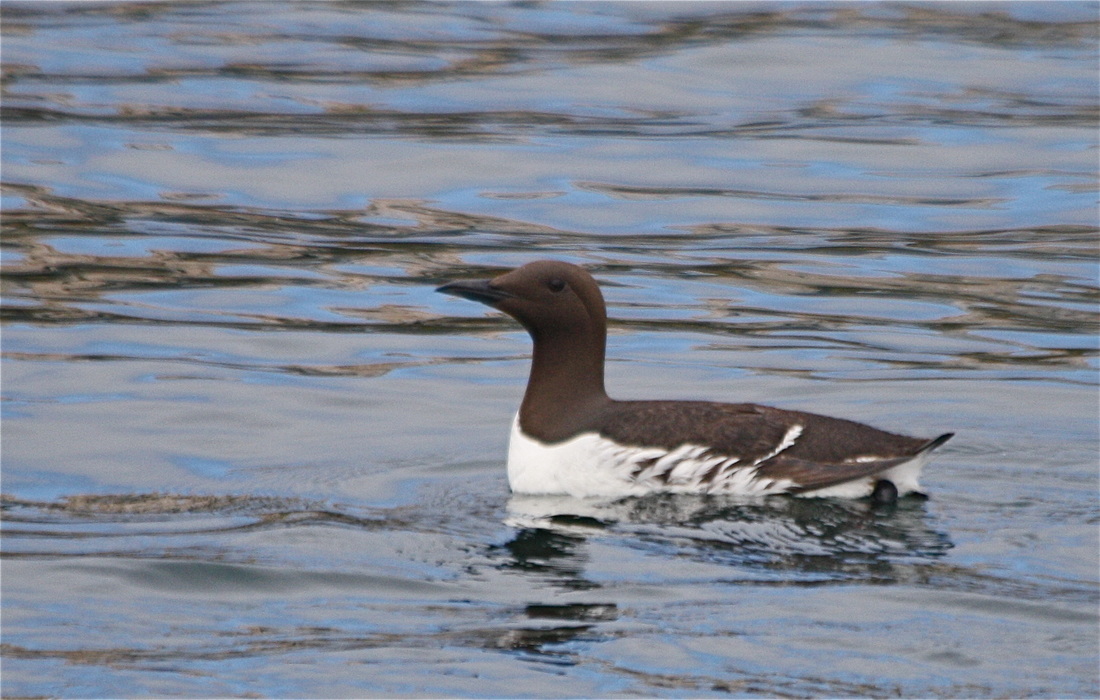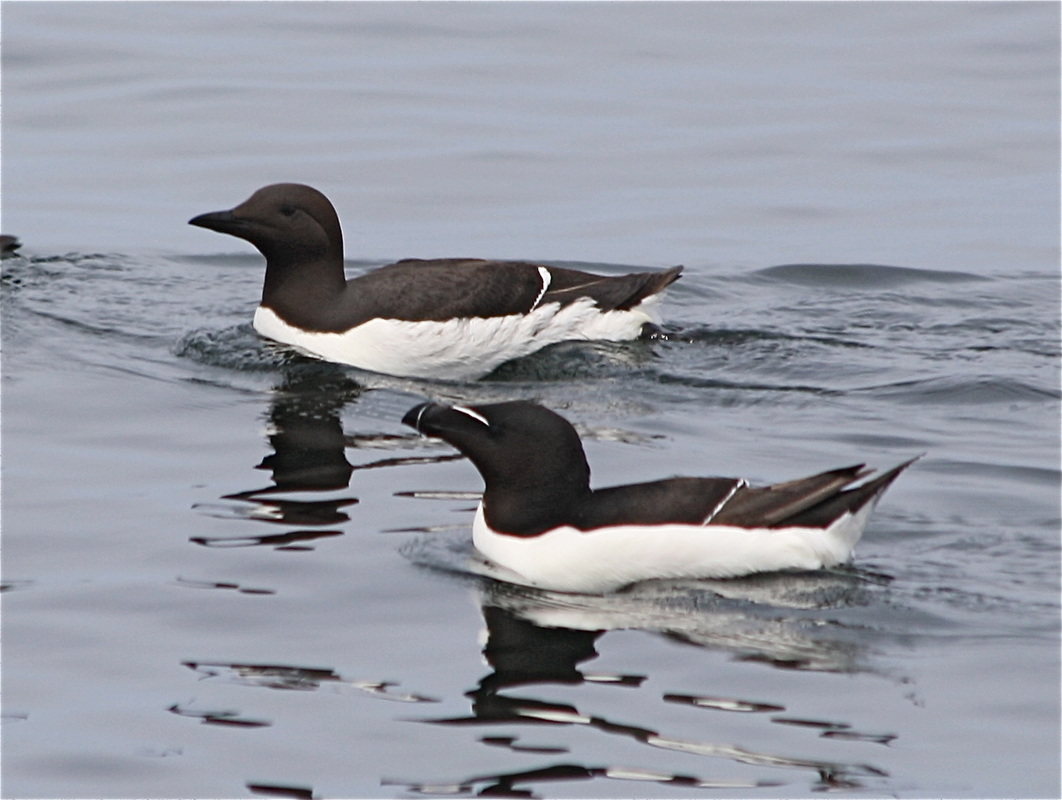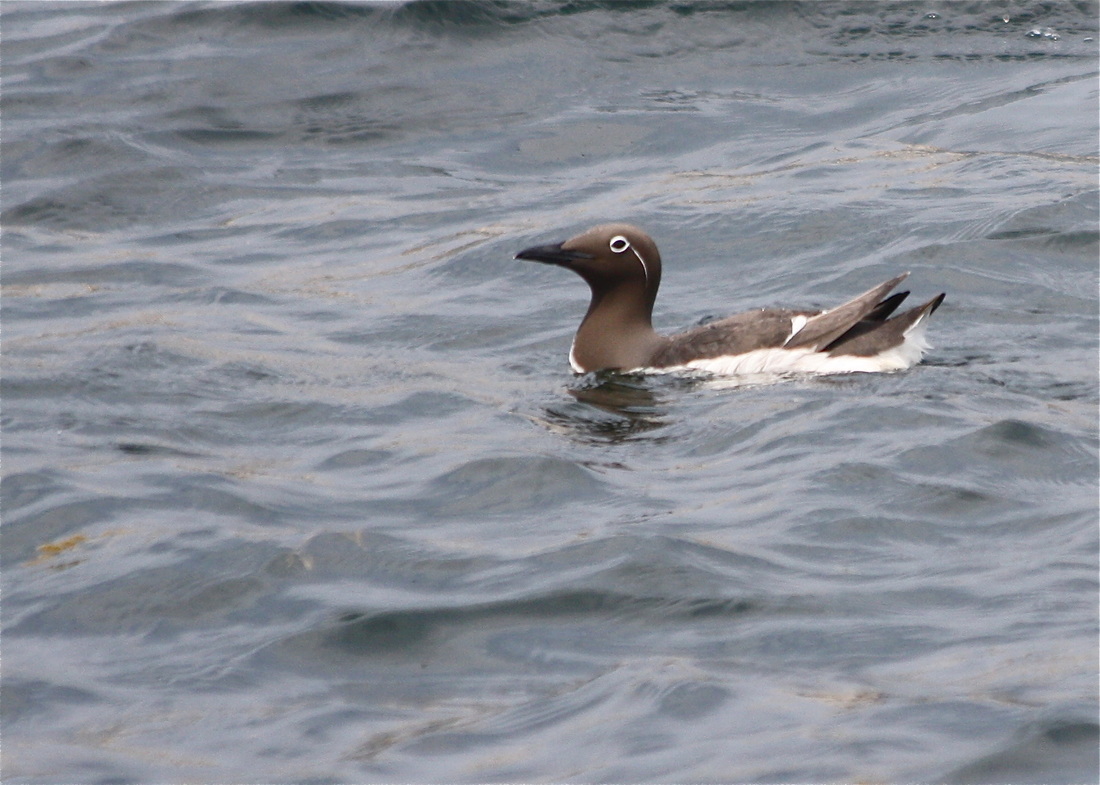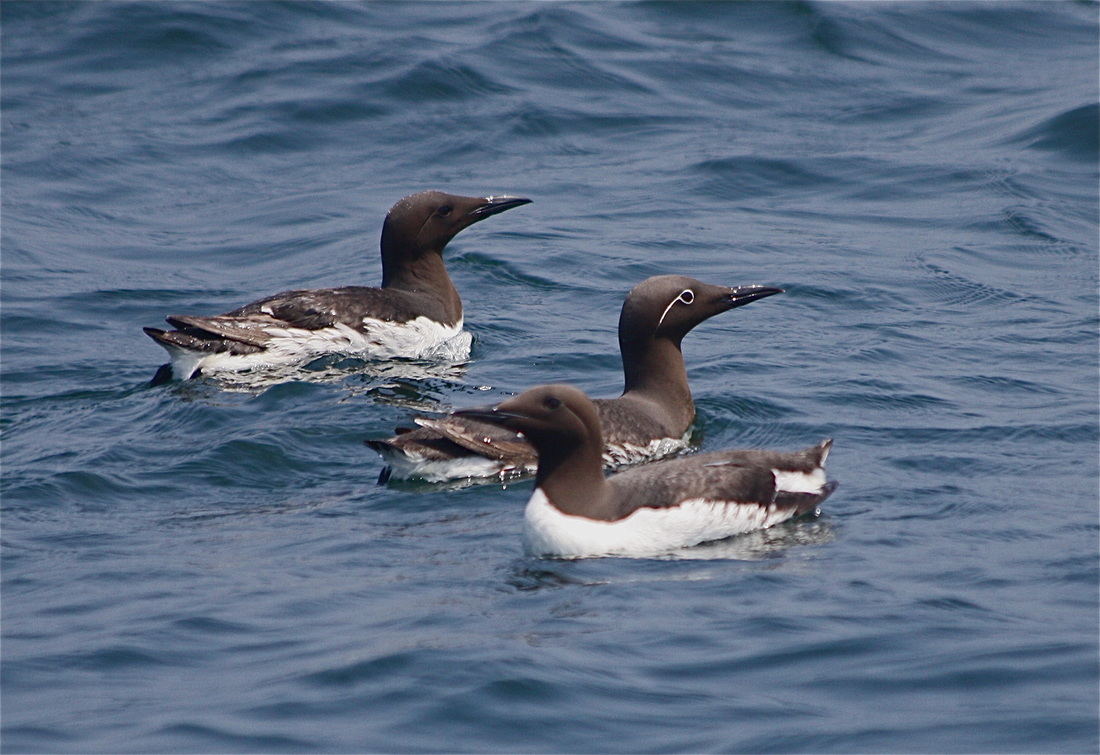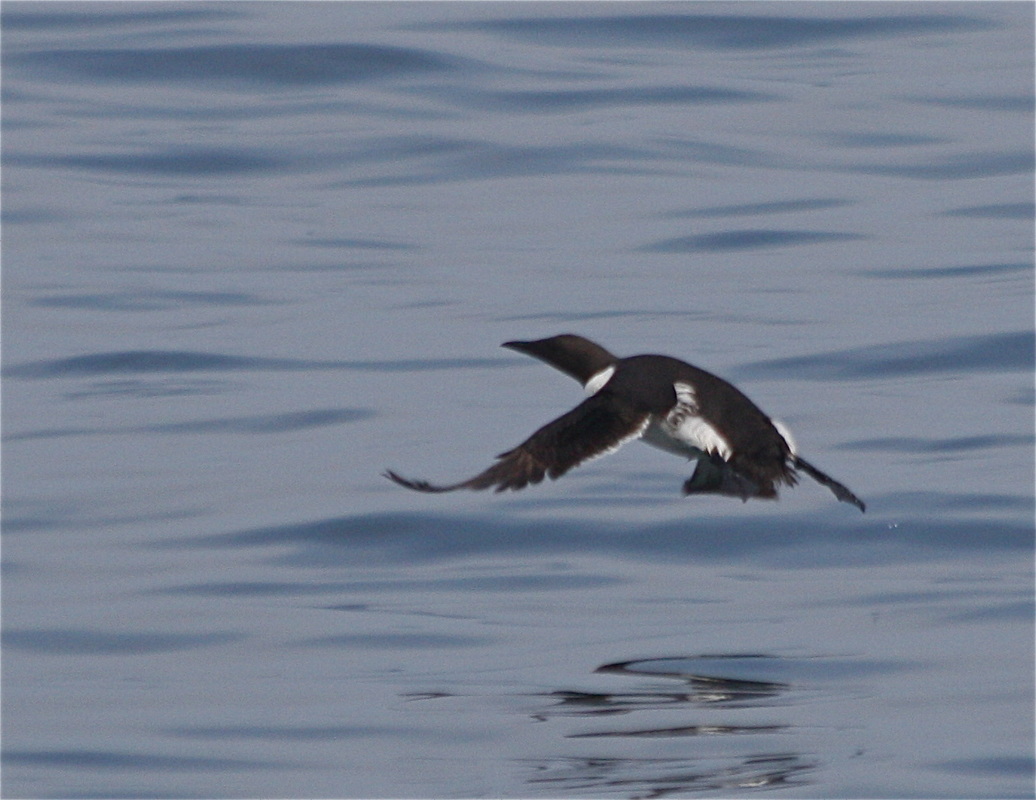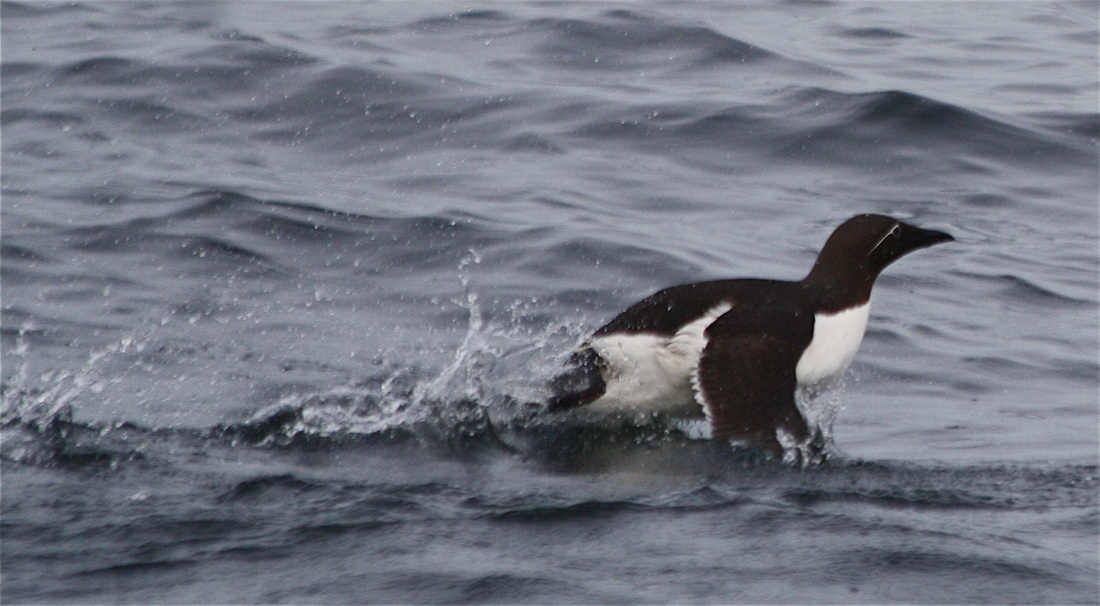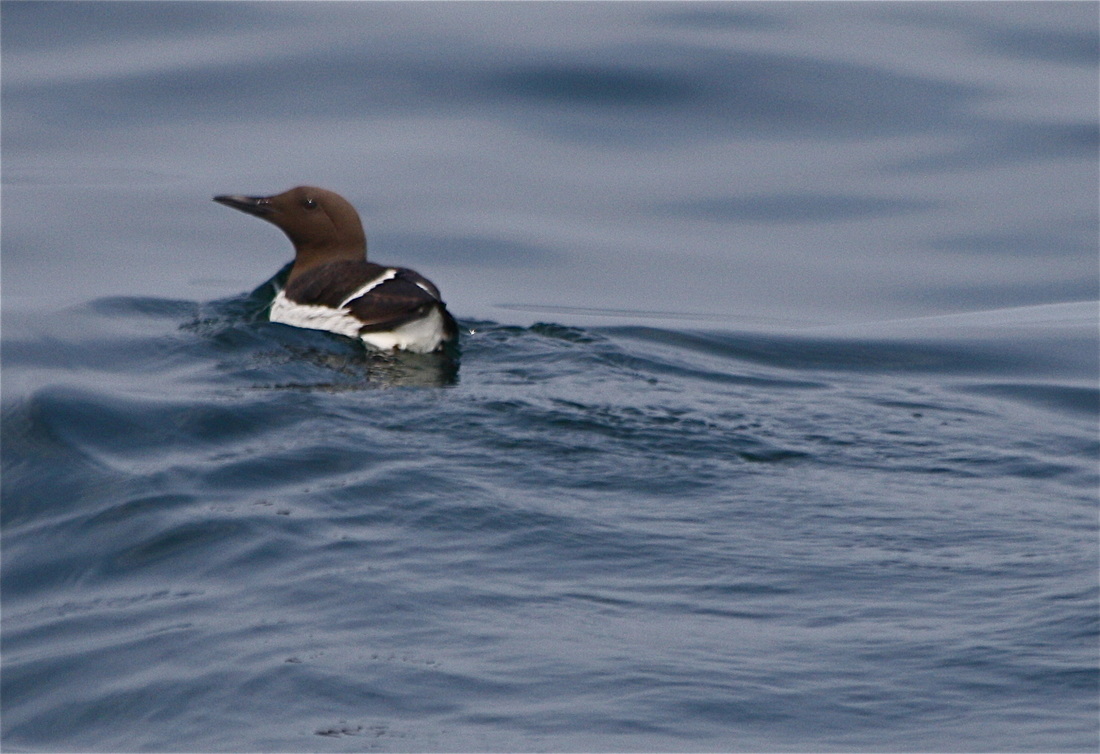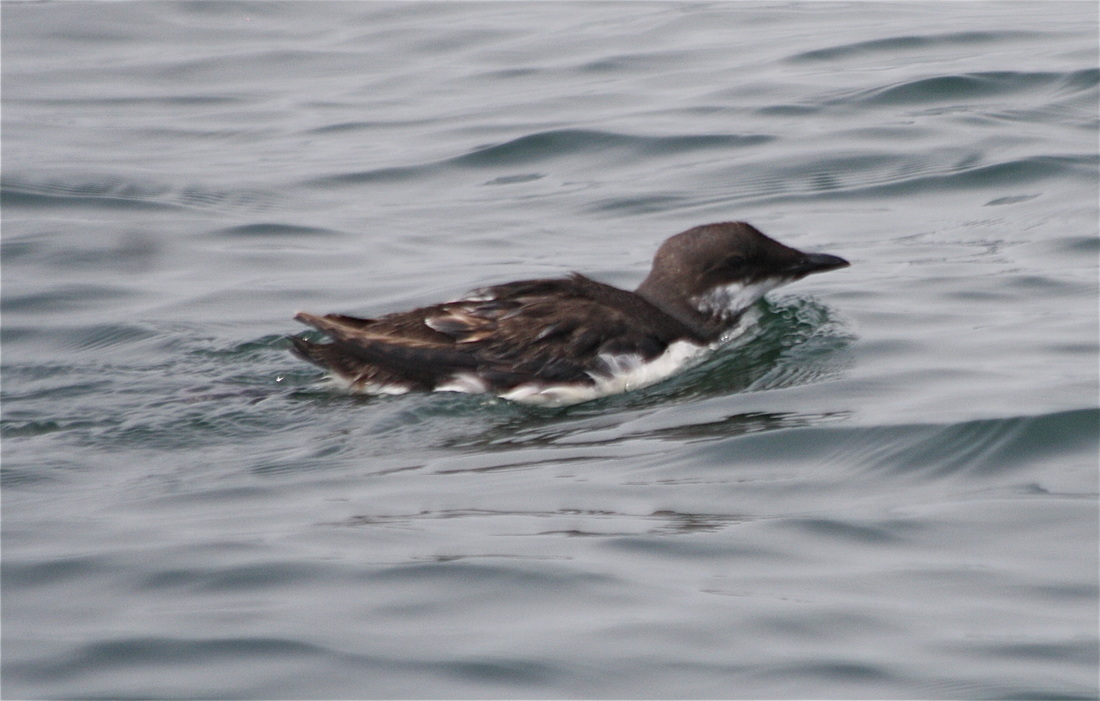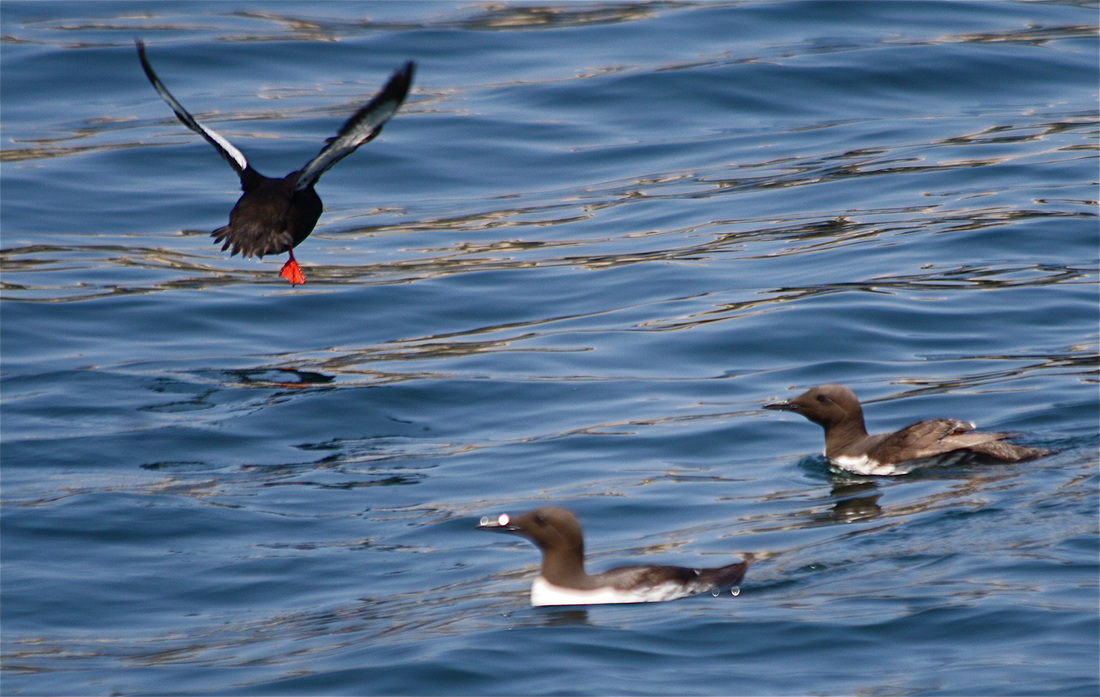Common Murres in Maine, the Growth of the regional population over the last 35 years.
This article was originally written in 2016,
some addition 2023
There are Murre seen almost everyday on trips to Seal Island May to early August.
Beginning in about 2018 murre have been laying eggs on Matinicus Rock, just a few but more than none.
The regional population of Murre is growing as have the populations of Razorbills and Puffins in the Gulf of Maine. The populations of all three of these species of alcids have been swelling in our direction during the spilling to the west from small crowded islands off Grand Manan Machias Seal and Yellow Murre ledge.
This article was originally written in 2016,
some addition 2023
There are Murre seen almost everyday on trips to Seal Island May to early August.
Beginning in about 2018 murre have been laying eggs on Matinicus Rock, just a few but more than none.
The regional population of Murre is growing as have the populations of Razorbills and Puffins in the Gulf of Maine. The populations of all three of these species of alcids have been swelling in our direction during the spilling to the west from small crowded islands off Grand Manan Machias Seal and Yellow Murre ledge.
Murre, Puffin, Razorbill, Seal Island. July 2014
Yellow Murre Ledge June 5 2004, not very large, at high tide it might take about 10 minutes to crawl around it, you could thorough a rock clear over it East to West, North to south you would need a pretty good arm to do so, the point being that growing populations of Razorbills and Murres could fill the available habitat and inspire crowding fueled emigration fairly rapidly. As has apparently happened.
|
In 1973 W.A. Squires (from The Atlantic Alcidae, Nettleship and Birkhead) saw an adult and young Murre between Macias Seal and Grand Manan, in 1980 Nancy Gunnlaugsson saw the same thing in the same area. Inspired by those reports My father (Bill Drury) and I went down to Yellow Murre ledge over memorial day weekend of '81,There we saw about 50 adult Common Murre and ashore we saw about 25 murre eggs, there were razorbills breeding there as well.
At left are what were our boats, Guillemot, appropriately, 36' Quoddy head pilot boat, formerly a College of the Atlantic research vessel. We went ashore in that nice glass novi dory being towed. there is a large gap between Yellow Murre Ledge and the next known nesting site of this Species, |
Yellow Murre ledge June 4 2004
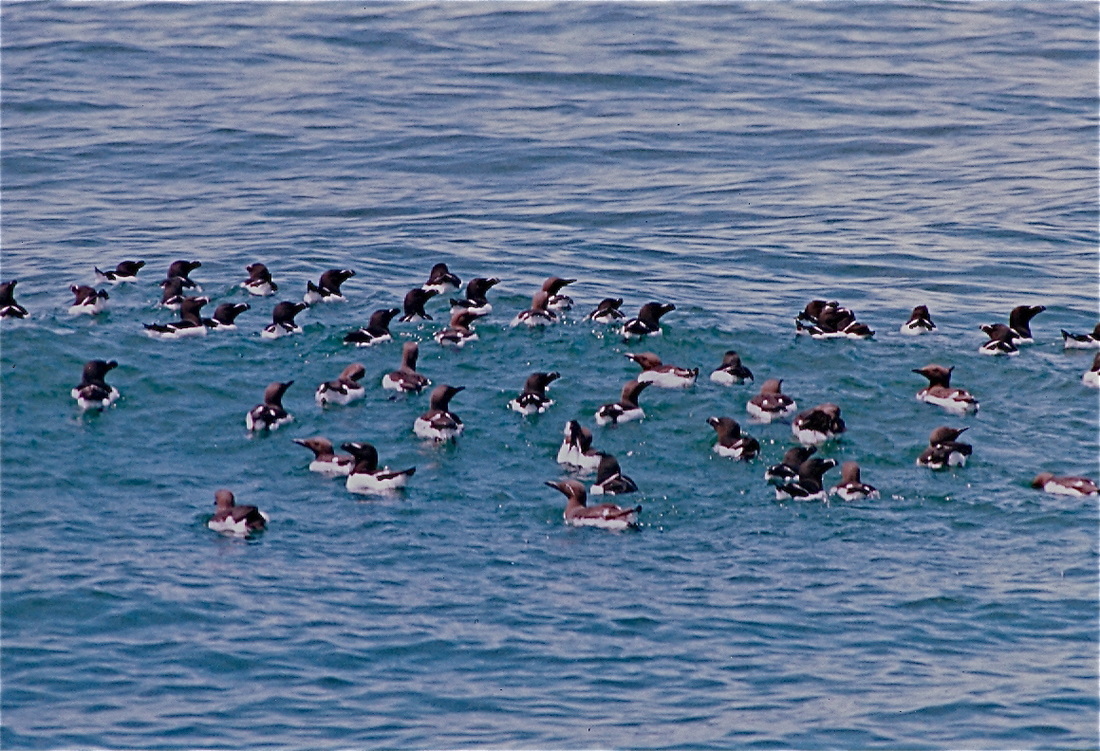
mixed razorbill and murre flock, the razorbills are black, Yellow Murre ledge June 4 2004,
the Atlas of Eastern Canadian Seabirds, 1975, indicates no murre breeding in Nova Scotia. There is a breeding site indicated on Cape Breton Island Nova Scotia, in the account for common murrre in the Birds of North America Series from 2002, still that is a long way from Grand Manan.
the Atlas of Eastern Canadian Seabirds, 1975, indicates no murre breeding in Nova Scotia. There is a breeding site indicated on Cape Breton Island Nova Scotia, in the account for common murrre in the Birds of North America Series from 2002, still that is a long way from Grand Manan.
So how? and why? did these birds decide to colonize a new, (though clearly from the name historic) breeding site so far removed from where they themselves had been raised? and how many individuals were involved in this caper?
Murre and Razorbill, Seal Island
About one in five of the Murre in the area are ringed, or bridled, a sweet looking form absent from the pacific population of this species.
Murre in the gulf of Maine
1981 there were about 25 pairs of Murre at Yellow murre ledge the only nesting site in the gulf of Maine,
I went back there only twice since then, but did not go ashore, in 1998 we estimated that there were about 55 pairs, and In 2004 I estimated that there were about 300 individuals and about 125 pairs.
I asked Dr. Tony Diamond, professor at the University of New Brunswick Fredericton long time guide of research at Machias Seal, who represents the Atlantic Laboratory of Avian Research, about changes in the populations of Aclids on that Island, his generous response included the following,
"Murre counts are a real problem because they nest (now) only under big boulders so are impossible to count without causing great disruption. At first they laid out in the open, but the gulls found those soon enough and now they are all under big boulders. Different crews have different degrees of tolerance as to how much disruption they are willing to cause in order to counts eggs/chicks; as a result we have widely varying numbers in different years, from the 176 eggs/chicks in 2003 (the first year they laid, many right out in the open so very vulnerable to gull predation) to 233 in 2004, and two later counts noted as definitely underestimates. In 2014 we identified all the boulders ("caves") they were using and after the murres left, estimated the area under each cave; this came to 27 sq m in total. Murres like to pack in tight, and according to BNA their density can reach 25 pairs per sq m (! yes, really) and applying that to our 27 sq m of murreland gives an upper estimate of 625 pairs in 2014. The number of caves occupied has increased steadily over the last ten years, though we've not documented that as carefully as we might."
1981 there were about 25 pairs of Murre at Yellow murre ledge the only nesting site in the gulf of Maine,
I went back there only twice since then, but did not go ashore, in 1998 we estimated that there were about 55 pairs, and In 2004 I estimated that there were about 300 individuals and about 125 pairs.
I asked Dr. Tony Diamond, professor at the University of New Brunswick Fredericton long time guide of research at Machias Seal, who represents the Atlantic Laboratory of Avian Research, about changes in the populations of Aclids on that Island, his generous response included the following,
"Murre counts are a real problem because they nest (now) only under big boulders so are impossible to count without causing great disruption. At first they laid out in the open, but the gulls found those soon enough and now they are all under big boulders. Different crews have different degrees of tolerance as to how much disruption they are willing to cause in order to counts eggs/chicks; as a result we have widely varying numbers in different years, from the 176 eggs/chicks in 2003 (the first year they laid, many right out in the open so very vulnerable to gull predation) to 233 in 2004, and two later counts noted as definitely underestimates. In 2014 we identified all the boulders ("caves") they were using and after the murres left, estimated the area under each cave; this came to 27 sq m in total. Murres like to pack in tight, and according to BNA their density can reach 25 pairs per sq m (! yes, really) and applying that to our 27 sq m of murreland gives an upper estimate of 625 pairs in 2014. The number of caves occupied has increased steadily over the last ten years, though we've not documented that as carefully as we might."
Spreading toes for uplift during liftoff an a calm day.
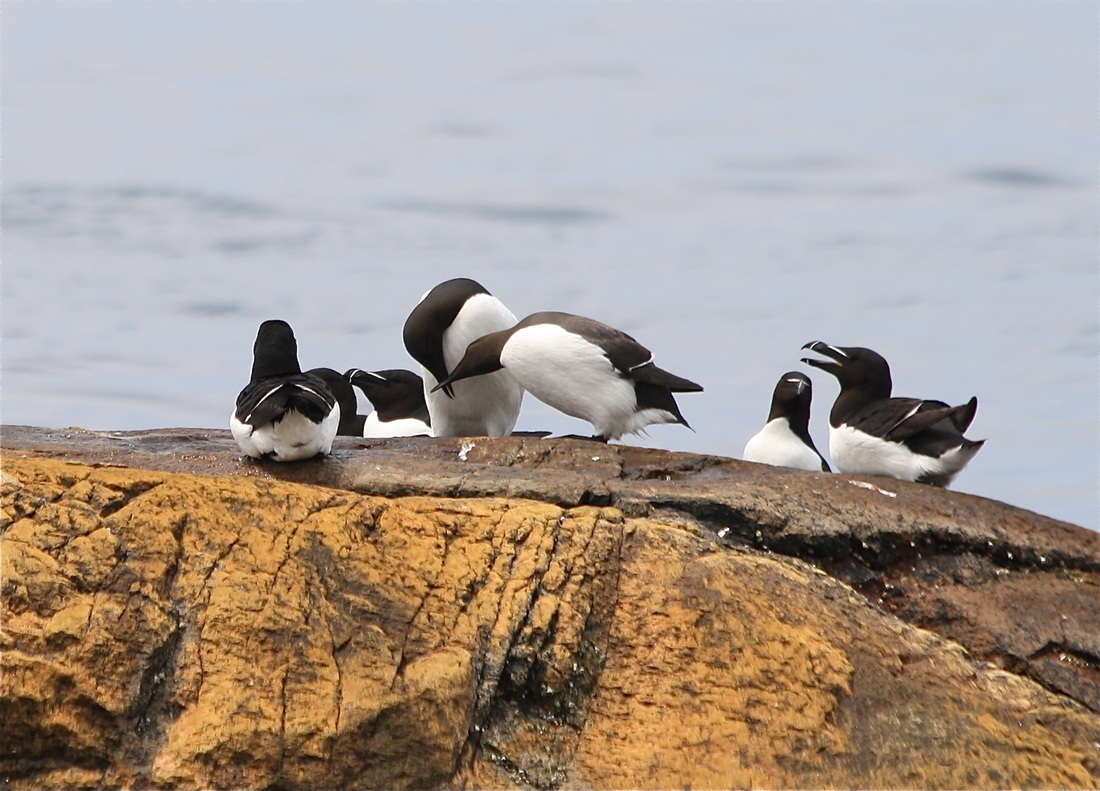
Two murre billing on the shore, with razorbills Matinicus Rock May 24 '09, taken from shore.
At Matinicus Rock in 2011 there was a high count for the season of 150 Murre, the number of individuals regularly attending seabird colonies at Petit Manan and Seal Island has also been increasing during the last 15 years.
At Matinicus Rock in 2011 there was a high count for the season of 150 Murre, the number of individuals regularly attending seabird colonies at Petit Manan and Seal Island has also been increasing during the last 15 years.
Murres, are really something fine, a first rate example of functional design, they can swim all weather, can dive very deep using wings, can fly, can walk, watertight, much to admire.
So rough estimates of the regional population of this species have grown form about 100 individuals in 1980 to about 800 individuals in 2004 to something like 1,500 individuals in 2014.
Thick-billed Murre near channel Rock July 14, 2015,
